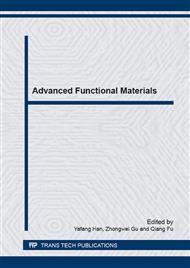p.429
p.434
p.440
p.446
p.451
p.458
p.464
p.470
p.477
Effect of Sericin Concentration on the Growth and Morphology of Escherichi Coli
Abstract:
Silk sericin composed of 18 amino acids has been widely used in the fields of cosmetic additives, food, medicine and functional biomaterials because of good hydrophilicity and biocompatibility, making it great possibility in providing abundant nutrients for microbial growth. Sericin (40~200 KDa) was used as culture medium for incubation of E. coli at 37°C to study the effect of sericin concentration on the growth of bacterial Escherichi coli (E. coli). The growth curves of E. coli, surface/inside morphology and protein of E. coli were investigated by UV/vis spectrophotometer (UV/vis), scanning electron microscopy (SEM), transmission electronic microscopy (TEM) and sodium dodecyl sulfate polyacrylamide gel electrophoresis (SDS-PAGE). The cytotoxicity of sercin was also confirmed by MTT assay. The value of OD600 increases with increasing sericin concentration from 0 to 40 g/L. Compared with the control, OD600 of 40 g/L sericin medium increases from 0.013 to 1.269 after incubated 12h. E. coli cell still remains rod shape regardless of concentration of sericin. The content of cellular soluble proteins significantly increases in sericin-treated bacteria, which in turn influenced the cell structure composition and catalyzing activity of enzyme, and finally stimulated the proliferation of E. coli. Results indicate that sericin can independently provide carbon and nitrogen for bacterial growth. Besides, it can promote bacterial protein expression without affecting cell morphology.
Info:
Periodical:
Pages:
451-457
Citation:
Online since:
March 2015
Authors:
Keywords:
Price:
Сopyright:
© 2015 Trans Tech Publications Ltd. All Rights Reserved
Share:
Citation:


